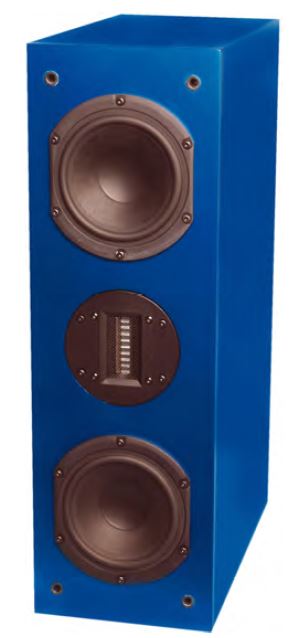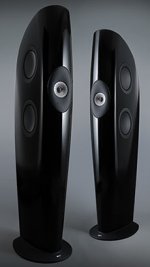Like the title states, I'm wondering if the driver pattern (specifically between the mids and tweeters) have a notable effect on the dispersion pattern? For example, if I have "the same" tower speaker and one is a MTM where the other is a MMT, would the dispersion pattern be noticeably different? Is one of those configurations better for a wider coverage pattern (such as a living room or outdoor area)?
The vertical directivity of a speaker depends on driver configuration. For example, a two-way speaker produces multiple lobes in its vertical radiation pattern whereas an MTM speaker minimises lobing and has a more symmetrical radiation pattern.
By suitable choice of crossover, the shape of the radiation pattern of an MTM speaker can be tweaked. For example, a second order crossover narrows the off-axis response to minimise room reflections, whereas a third order crossover widens the off axis response.
By suitable choice of crossover, the shape of the radiation pattern of an MTM speaker can be tweaked. For example, a second order crossover narrows the off-axis response to minimise room reflections, whereas a third order crossover widens the off axis response.
I say this rather theoretically, but a phase-aligned LR2 or LR4 MMT isn't going to sound much different from an MTM.
Joe D'Appolito became interested in the more power-flat (and impedance-flat when you eliminate bafflestep correction) BW3 Butterworth design. You can look Butterworth Filters up, they either have a +3dB frequency response bump at crossover or use 90 degree phase to line everything up flat (except assymetric lobing). TBH, we use a mere 2D Clifford Algebra in loudspeakers. The amazing Quaternions reveal the true nature of boosts and rotations in a 3D space. Curious quaternions | plus.maths.org
Why should you care? Just the higher algebras reveal our lack of clear thinking about the nature of rotation in our 3D space or 4D Lorentz spacetime. Some of these annoying effects are just built into our Universe, so best work with them IMO. In the D'Appolito solution you eliminate Lobing for Combing. With IIR digital filters in the future we might gain some conrol of time domain effects.
Joe missed a trick on dispersion. A ribbon tweeter works better on consistent cylindrical dispersion than a dome tweeter, which tends to inverse-distance power, rather than inverse square, that PA sound that uses less power for the same loudness on axis:

What about all this group delay or ringing associated with filtering? Well, you have actually heard zero group delay on any pair of headphones you buy. IMO, this sort of MTTM design doesn't sound noticeably worse. 🙂
Joe D'Appolito became interested in the more power-flat (and impedance-flat when you eliminate bafflestep correction) BW3 Butterworth design. You can look Butterworth Filters up, they either have a +3dB frequency response bump at crossover or use 90 degree phase to line everything up flat (except assymetric lobing). TBH, we use a mere 2D Clifford Algebra in loudspeakers. The amazing Quaternions reveal the true nature of boosts and rotations in a 3D space. Curious quaternions | plus.maths.org
Why should you care? Just the higher algebras reveal our lack of clear thinking about the nature of rotation in our 3D space or 4D Lorentz spacetime. Some of these annoying effects are just built into our Universe, so best work with them IMO. In the D'Appolito solution you eliminate Lobing for Combing. With IIR digital filters in the future we might gain some conrol of time domain effects.
Joe missed a trick on dispersion. A ribbon tweeter works better on consistent cylindrical dispersion than a dome tweeter, which tends to inverse-distance power, rather than inverse square, that PA sound that uses less power for the same loudness on axis:
What about all this group delay or ringing associated with filtering? Well, you have actually heard zero group delay on any pair of headphones you buy. IMO, this sort of MTTM design doesn't sound noticeably worse. 🙂
Last edited:
TBH, bwaslo, you are having a distracting laugh with your notion of FIR.
I studied analog and digital filters at University MSc level, under the excellent guidance of Professor Tony Constantinides at Imperial College in London. Home - Emeritus Professor Tony Constantinides
I cannot recommend Tony's insight enough. To reverse time you need IIR. In the morning we'd study the various solutions to the filter processes. In the afternoon we'd study the best wines to drink and have a laugh about our own basic ignorance. 😀
I really don't know how I appreciate that extremely rare female approach to Engineering and Physics and Mathematics. I think Emmy Noether was way ahead of her time. Hyper-Complex variable? Really? 😎
In our 21C era, we have the lovely lady Cohl Furey. Never mind the hairstyle and Bangs. A good mathematician: YouTube
I studied analog and digital filters at University MSc level, under the excellent guidance of Professor Tony Constantinides at Imperial College in London. Home - Emeritus Professor Tony Constantinides
I cannot recommend Tony's insight enough. To reverse time you need IIR. In the morning we'd study the various solutions to the filter processes. In the afternoon we'd study the best wines to drink and have a laugh about our own basic ignorance. 😀
I really don't know how I appreciate that extremely rare female approach to Engineering and Physics and Mathematics. I think Emmy Noether was way ahead of her time. Hyper-Complex variable? Really? 😎
In our 21C era, we have the lovely lady Cohl Furey. Never mind the hairstyle and Bangs. A good mathematician: YouTube
Last edited:
Most of the sound in the vertical plane, hits the ears at the same time and can therefore be less of a problem. So MTM is not always better than MT - as long as you have control of the phase in the XO. I use 4 LR and measure the driveres individualy and then EQ them, find optimal level(gain) and also measure off-axis to know where my midrange starts beaming, so that I can minimize the effect of a narrowing dispersion in the summed pattern when crossing from the midrange to the tweeter.Like the title states, I'm wondering if the driver pattern (specifically between the mids and tweeters) have a notable effect on the dispersion pattern? For example, if I have "the same" tower speaker and one is a MTM where the other is a MMT, would the dispersion pattern be noticeably different? Is one of those configurations better for a wider coverage pattern (such as a living room or outdoor area)?
FIR filters can in theory be better, but require much more care with measurements and filterdesign.
If you build and design a loudspeaker with respect to acoustical limits and shortcommings, then IIR should still be valid, since small phase problems are not something we hear easily.
Side note - MTM is good for another thing though. If you have two mids and maybe also two base drivers, then the sensitivity will match the tweeter better, and filtering should be easier and you can play louder.
But MTM needs to be physically close - short distance between drivers for the XO to work properly.
Last edited:
MT, MMT and MTM have different vertical dispersion. Horizontal is the same.
A good thread MTM - TMM Shoot Out
Many free simulations can be used to study this, eg. Tolvan Data, but xDir can't do a 2,5 system.
A good thread MTM - TMM Shoot Out
Many free simulations can be used to study this, eg. Tolvan Data, but xDir can't do a 2,5 system.
All I can say to that is i2 = j2 = k2 = ijk = -1The amazing Quaternions reveal the true nature of boosts and rotations in a 3D space.

P.S. I've often been told to go forth and multiply!
To reverse time you need IIR.
Hi,
Are you referring to zero phase?
Where IIR is applied bidirectionally?
To reverse time you need IIR.
Ok, part 2
PLS nevermind previous questions...
I see zero phase, bidirectional IIR, requires a signal storage buffer to 'look backwards in time',
so in my mind it has the same latency issue as linear phase FIR does,
but with much greater computational complication.
It's kinda easy to see why zero phase hasn't made a splash...
So there's no real time reversal......it takes time to fix time, eh? 😉
- Status
- Not open for further replies.
- Home
- Loudspeakers
- Multi-Way
- Does the driver pattern change the dispersion pattern?
